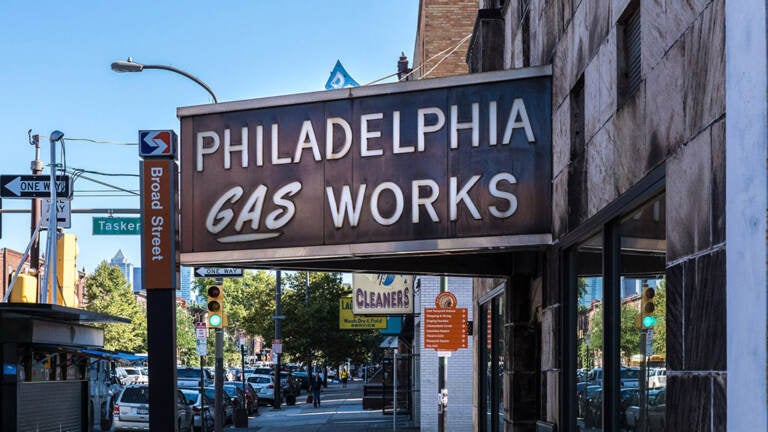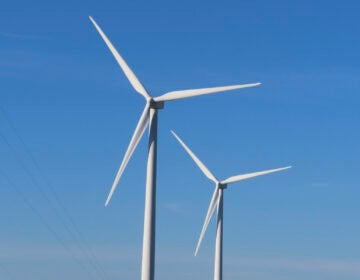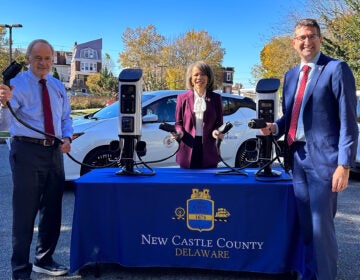City Council hears options for decarbonizing Philadelphia Gas Works. Divergent visions of the future emerge
The hearing’s focus was the 81-page PGW Business Diversification Study. Utility CEO Seth Shapiro offered one view; environmentalists, another.
Listen 1:54
A Philadelphia Gas Works sign is pictured on South Broad Street. (Danya Henninger/Billy Penn)
Two different visions of Philadelphia Gas Works’ future emerged from a City Council hearing Wednesday. The focus of the hearing was the 81-page PGW Business Diversification Study released in December, which aims to tackle the difficult question of how the city can meet its climate goals while also owning a fossil fuel company that contributes a large portion of global warming emissions as it provides heating and cooking gas to city residents.
Philadelphia’s goal of carbon neutrality by 2050 runs smack up against the reality that natural gas creates 24% of the city’s carbon emissions.
PGW’s new CEO, Seth Shapiro, testifying before the council’s joint committee on finance and transportation and public utilities, acknowledged the existential threats of climate change and committed the utility to Mayor Jim Kenney’s climate goal. But Shapiro also touted a future in which natural gas continues to play a large role in providing electricity nationwide, while continuing to heat Philadelphia homes.
“To address that threat, we have to use every greenhouse gas reduction strategy there is,” Shapiro said. “Growth in renewables alone cannot be the solution. It is equally irrefutable that right now, today, natural gas is perhaps the most significant tool for greenhouse gas reductions worldwide. The overwhelming majority of greenhouse gas reductions we’ve seen over the past few decades have come from the transition from coal and heating oil to natural gas. When we’re making real decisions, we have to weigh all the facets and we have to focus on … the repercussions of the policy decisions we make.”
Coal and oil do produce more carbon emissions and harmful air pollutants than natural gas when burned at a power plant. But increasingly, studies show that methane, which leaks from wellheads and pipelines, can be as much as or even more damaging than coal because as a greenhouse gas methane is a more potent climate warming pollutant. Cooking gas from ovens and stoves also contributes, and new studies show that indoor air pollution can exacerbate asthma.
Shapiro pointed to current electricity production in Pennsylvania — 40% from natural gas, 20% from coal, 20% from nuclear energy, and less than 5% from renewables — to make the case that electrification is farther into the future than some would like to admit.
“The growth that we’re seeing in renewable generation cannot keep up with the growth in demand for electricity,” he said. “There’s not a single projection in growth in renewables that gets you to where demand is today, much less than where demand will be [in the coming decades].”
Climate scientists and advocates say the push toward electrification is key to reducing climate emissions in order to stave off an acceleration of the worst impacts, including fires, droughts, and floods. A report issued by the International Energy Agency last May said governments need to do a number of things to bring carbon dioxide emissions to net zero by 2050, including banning new oil and gas furnaces by 2025. And that presents an existential crisis for utilities such as PGW.
While Shapiro said he saw a future for natural gas to continue as a dominant fuel source for electricity, he also questioned the efficiency of electrification of heat. Natural gas “produced close to twice as much energy at half the cost with fewer emissions,” he said. “Those facts alone demonstrate an integral part PGW plays in meeting the city’s carbon reduction goals.”
The PGW Diversification Study itself, however, states that electrification of heat would reduce emissions.
Shapiro said PGW is reducing its carbon emissions by replacing its aging, and leak-prone cast-iron pipes. The utility spent $85 million to replace 37 miles of pipe last year, adding that every five miles of new pipe eliminates 23 metric tons of methane, he said. PGW has also spent $75 million over the last ten years to weatherize 25,000 low-income homes, which reduced emissions by 120,000 metric tons of carbon dioxide equivalent.
The diversification report recommends further study into three separate future pathways for PGW: geothermal energy; expanded weatherization; and harvesting sewer gas or landfill gas that produces methane. Shapiro said PGW is committed to exploring all three.
Environmentalists voice concerns
Despite assurances from Shapiro that PGW is on board with the city’s climate goals, environmentalists questioned those commitments, and painted a future in which PGW could transition to networked geothermal.
“The most glaring flaw in the study is its underlying assumption that the city-owned utility must continue to operate primarily as a gas utility,” said Logan Welde, staff attorney with the Clean Air Council. “And Mr Shapiro’s testimony today did not allay these fears. It was essentially an infomercial for continuing to use gas.”
Welde cited reporting by WHYY News regarding PGW’s support in drafting a bill that preempts municipalities from enacting their own electrification rules as evidence of PGW’s ambivalence over decarbonization. Emails obtained through a Right to Know request show that some of the same PGW executives who participated in the diversification study helped draft legislation that could tie the city’s hands when it comes to electrification.
Welde and others also criticized the study for not going far enough.
“I’m here today to testify in support of a full transition of PGW away from gas to 100% clean energy and to oppose any efforts that will make that transition more difficult,” said Flora Cardoni, field director for PennEnvironment. “Ending our reliance on dirty, dangerous fossil fuels will help lower global warming emissions, clean up our air, and protect our health. We’re also in support of a plan centered around full electrification, with PGW transitioning completely off of gas into a 100% clean energy.”
All the environmentalists panned the decarbonized gas option as too expensive, and not sufficiently aggressive to reduce the utility’s carbon footprint. They also urged the city to have PGW do a geothermal pilot study as soon as possible, saying anything that hints at “feasibility” is a waste of time given the technology is not new and builds upon other examples at college campuses. Geothermal advocates say while the upfront infrastructure costs are high, it would be money better spent than taking more than 30 years to replace PGW’s aging pipeline system. And once the system is installed, they say it reduces heating and cooling bills.
Other factors: PGW’s workers and customers
The issue is complicated by the potential impact on PGW’s 1,600-member workforce and its 500,000 ratepayers, almost one-quarter of whom live below the federal poverty level. Philadelphians spend on average 6.7% of their income on energy, double the national average. Christine Knapp, the city’s sustainability director, testified at Wednesday’s hearing that 118,000 households suffer from “severe energy burden.”
“This issue is at the nexus of climate, housing and affordability,” Knapp said. The average monthly bill for PGW customers is $102.
Community Legal Services, which serves as the public advocate in cases before the Philadelphia Gas Commission, criticized the diversification study’s proposed weatherization plan, which essentially would turn PGW into a bank that would loan money to customers for home efficiency upgrades. CLS staff attorney Joline Price said that those programs should be free, and that there’s plenty of money in the federal infrastructure bill to fund increased weatherization.
“The diversification study’s suggestion that PGW provide loans and financing to low-income customers for customer-side energy upgrades is, simply put, a bad idea,” said Price. “When we talk about Philadelphia households that are already struggling to get by, we cannot be adding more to their cost burden.”
The PGW Diversification Study was primarily funded by Bloomberg Philanthropies after the city won a competitive grant in 2018 and hired the consultant Energy, Environment, Economic. Spearheaded by the city’s Office of Sustainability, the study included the participation of PGW executives, the Philadelphia Gas Commission, Philadelphia Facilities Management Corp., the Philadelphia Energy Authority, and PGW’s unionized workforce, Gas Workers Local 686. It also included public participation and comments.
PGW’s union has criticized some of the proposals as job-killers and cost-prohibitive for ratepayers, but no representatives testified at the hearing.
The diversification study outlines a number of challenges facing the city and PGW, including the complicated regulatory structure governing the utility — which, in addition to the city, includes the Philadelphia Gas Commission, which oversees PGW’s budget; the nonprofit Philadelphia Facilities Management Corp., which manages day-to-day operations at PGW; and the Pennsylvania Public Utility Commission, which approves rates.
City Councilmember Derek Green, who led the hearing and chairs the Gas Commission, explained how state regulations have hampered PGW from diversifying in the past. The utility wanted to expand to renewable natural gas but was blocked by the Public Utility Commission because of high costs. The utility is required to purchase the most affordable natural gas.
“A key challenge, highlighted by this study, is that there is not currently a clear legal or regulatory path forward for PGW to pursue many of the diversification and decarbonization strategies discussed in this report,” the study says. “Regulatory considerations might include efforts to reduce costs of the gas system, changes in how gas system costs are recovered and allocated, and programs to protect low- and moderate-income customers from rising costs.”
And while the study says reaching net zero is technologically feasible through electrification of heating and cooking, use of decarbonized gas, and geothermal energy systems, questions remain as to how that would be achieved without putting PGW out of business. Those options come at a cost that could include stranded assets for PGW, high upfront capital investments, and potential increases for ratepayers, according to the report.
“Regardless of the greenhouse gas reduction pathways pursued, PGW’s existing legal and regulatory structure and cost recovery mechanism does not position the utility to be able to support achievement of the city’s carbon neutrality goal,” the report says. “For example, building electrification, though potentially beneficial to customers who can electrify their buildings, and supportive of the city’s climate and equity goals, at scale, reduces PGW’s long-term financial viability under the current regulatory framework.”

Saturdays just got more interesting.
WHYY is your source for fact-based, in-depth journalism and information. As a nonprofit organization, we rely on financial support from readers like you. Please give today.





